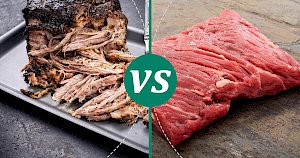Brisket vs Pulled Pork (No Souce): The Healthier Choice
Where is more calories, protein, carbs - what is more healthy?


Pulled pork vs Brisket: Nutrition Comparison
| per 100g | Brisket | Pulled pork (no souce) |
|---|
Calories in Brisket
At first glance, you can see that in brisket is much calories than in pulled pork.
Brisket has 157 kcal per 100g and pulled pork kcal per 100g so it is pretty easy to calculate that the difference is about 0%.
Additionally, it is also easy to notice that most of the calories in brisket cames from protein and in pulled pork from carbs.
See tables below to compare brisket with pulled pork in details.
Brisket And Pulled pork Nutrition Difference
Calories source
- 2% CARBS.
- 55% PROTEIN
- 44% FAT
Pulled pork (no souce)
kcal100g | ounce | standard serving size | half cup
Calories source
- 0% CARBS
- 0% PROTEIN
- 0% FAT
Vitamins: pulled pork vs brisket
Minerals: brisket vs pulled pork
Compares of brisket
- Brisket vs Pork
- Brisket vs Steak
- Brisket vs Beef
- Brisket vs Pork Tenderloin
- Brisket vs Ribeye Steak
- Brisket vs Roast Beef
- see all compares of brisket
Compares of pulled pork
- see all compares of pulled pork
Read also:
- Calories from Brisket
- Calories of Pastrami sandwich
- Calories in Egg benedict
- Ice coffee calories per 100g
- Gyro sandwich carbs per 100g
- Heavy whipping cream protein per 100g
- Ranch dressing fat per 100g
- How many calories do scallops have?
- Calories in a half of baby carrot
- Calories in whole baby carrot
- Calories for one, two or more baby carrots
- How much protein in cooked sweet potato?
Marcin Piotrowicz
calories-info.com creator
Healthy diet and healthy lifestyle promoter
Add comment